 Afrikaans
Afrikaans  Albanian
Albanian  Amharic
Amharic  Arabic
Arabic  Armenian
Armenian  Azerbaijani
Azerbaijani  Basque
Basque  Belarusian
Belarusian  Bengali
Bengali  Bosnian
Bosnian  Bulgarian
Bulgarian  Catalan
Catalan  Cebuano
Cebuano  Corsican
Corsican  Croatian
Croatian  Czech
Czech  Danish
Danish  Dutch
Dutch  English
English  Esperanto
Esperanto  Estonian
Estonian  Finnish
Finnish  French
French  Frisian
Frisian  Galician
Galician  Georgian
Georgian  German
German  Greek
Greek  Gujarati
Gujarati  Haitian Creole
Haitian Creole  hausa
hausa  hawaiian
hawaiian  Hebrew
Hebrew  Hindi
Hindi  Miao
Miao  Hungarian
Hungarian  Icelandic
Icelandic  igbo
igbo  Indonesian
Indonesian  irish
irish  Italian
Italian  Japanese
Japanese  Javanese
Javanese  Kannada
Kannada  kazakh
kazakh  Khmer
Khmer  Rwandese
Rwandese  Korean
Korean  Kurdish
Kurdish  Kyrgyz
Kyrgyz  Lao
Lao  Latin
Latin  Latvian
Latvian  Lithuanian
Lithuanian  Luxembourgish
Luxembourgish  Macedonian
Macedonian  Malgashi
Malgashi  Malay
Malay  Malayalam
Malayalam  Maltese
Maltese  Maori
Maori  Marathi
Marathi  Mongolian
Mongolian  Myanmar
Myanmar  Nepali
Nepali  Norwegian
Norwegian  Norwegian
Norwegian  Occitan
Occitan  Pashto
Pashto  Persian
Persian  Polish
Polish  Portuguese
Portuguese  Punjabi
Punjabi  Romanian
Romanian  Russian
Russian  Samoan
Samoan  Scottish Gaelic
Scottish Gaelic  Serbian
Serbian  Sesotho
Sesotho  Shona
Shona  Sindhi
Sindhi  Sinhala
Sinhala  Slovak
Slovak  Slovenian
Slovenian  Somali
Somali  Spanish
Spanish  Sundanese
Sundanese  Swahili
Swahili  Swedish
Swedish  Tagalog
Tagalog  Tajik
Tajik  Tamil
Tamil  Tatar
Tatar  Telugu
Telugu  Thai
Thai  Turkish
Turkish  Turkmen
Turkmen  Ukrainian
Ukrainian  Urdu
Urdu  Uighur
Uighur  Uzbek
Uzbek  Vietnamese
Vietnamese  Welsh
Welsh  Bantu
Bantu  Yiddish
Yiddish  Yoruba
Yoruba  Zulu
Zulu drum pulley
The Evolution and Importance of Drum Pulleys in Modern Machinery
Drum pulleys are fundamental components in various mechanical systems, serving as critical elements that facilitate the smooth operation of conveyor belts, elevators, and numerous industrial applications. The evolution of drum pulleys reflects both advancements in engineering and the ever-growing demands of modern industries. This article explores the design, functionality, and significance of drum pulleys in contemporary machinery.
What is a Drum Pulley?
A drum pulley is a cylindrical component around which a belt is wound or wrapped. It plays a pivotal role in transmitting power and motion in mechanical systems. Typically made from materials such as steel, aluminum, or composites, the design of drum pulleys can vary widely depending on their intended application. They can be categorized into different types, including drive pulleys, tail pulleys, and snub pulleys, each serving a unique function in a system.
Design Considerations
The design of drum pulleys is influenced by various factors, such as the operating environment, load capacity, and required speed. In many cases, they must be able to withstand harsh conditions, including extreme temperatures, abrasive materials, and heavy loads. Therefore, the choice of materials and surface treatments becomes crucial. Many drum pulleys feature a rubber coating to enhance traction and reduce wear on the conveyor belt.
The size and diameter of drum pulleys also play a significant role in their functionality
. Larger pulleys can handle heavier loads and are more efficient for moving materials over long distances, while smaller pulleys are often used for tighter spaces or more precise applications. Moreover, the configuration of the pulley, whether it be crowned or flat, can affect the belt alignment and overall system efficiency.Applications in Industry
drum pulley

Drum pulleys are widely used across various industries, from mining and construction to food processing and manufacturing. In material handling systems, for example, they are essential in moving bulk materials like coal, grain, and aggregates from one point to another. The efficiency of these systems often hinges on the reliability and performance of drum pulleys.
In the manufacturing sector, drum pulleys are integral to assembly lines, enabling the smooth transport of goods from one station to the next. Additionally, in the elevator industry, drum pulleys are crucial for lifting operations, where they help control the movement of elevator cars within buildings.
The Role of Technology
With the advent of advanced technology, the design and manufacturing of drum pulleys have seen significant improvements. Computer-aided design (CAD) software allows engineers to simulate and optimize the performance of pulleys before they are manufactured. This technology not only enhances the precision of dimensions but also enables the analysis of stress and strain, ensuring that the pulleys can endure their intended operational conditions.
Moreover, innovations in materials science have led to the development of lighter and stronger materials, improving the efficiency and durability of drum pulleys. These advancements contribute to the overall performance of machinery, leading to reduced downtime and maintenance costs.
Conclusion
In summary, drum pulleys play an indispensable role in a wide array of mechanical systems. Their design and functionality are critical to the efficiency and reliability of machinery across various industries. As technology continues to advance, the evolution of drum pulleys will likely lead to even more significant improvements in performance and sustainability. This ongoing development reaffirms the importance of drum pulleys in driving innovation and efficiency in modern industrial applications, ensuring they remain a cornerstone of mechanical engineering for years to come.
-
Revolutionizing Conveyor Reliability with Advanced Rubber Lagging PulleysNewsJul.22,2025
-
Powering Precision and Durability with Expert Manufacturers of Conveyor ComponentsNewsJul.22,2025
-
Optimizing Conveyor Systems with Advanced Conveyor AccessoriesNewsJul.22,2025
-
Maximize Conveyor Efficiency with Quality Conveyor Idler PulleysNewsJul.22,2025
-
Future-Proof Your Conveyor System with High-Performance Polyurethane RollerNewsJul.22,2025
-
Driving Efficiency Forward with Quality Idlers and RollersNewsJul.22,2025





























